HAMPI
(Photos of Hampi
are here)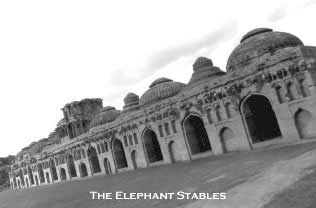
Hampi was founded by the Hindu Vijayanagar dynasty in 1336 AD, and quickly
became one of, if not THE most brilliant capital in all India.
At its apogee, its population numbered in the hundreds of thousand and
it spread over 30 square kilometers!!
When four Muslim sultans of the Deccan, unable to bear any longer the
arrogance of the Hindu Raja united to take it, it fell after the battle
of Talikota in 1565. The Hindu host is said to have numbered 600,000 foot
soldiers, 100,000 horses and nearly 1000 elephants! All for naught!
The sack of the city lasted for five months, and the heat of the fire
is said to have cracked the huge basaltic rock hills scattered all over!
'Never perhaps in history had such havoc been wrought on so splendid a
city, wealthy and prosperous one day, and on the next, seized, pillaged
and reduced to ruins, amid scenes of savage massacre and horrors beggaring
description' (Sewell).
Today, all that remains are many perfectly preserved temples dedicated
to the myriad gods of the Hindu pantheon, parts of SEVEN huge rings of
fortifications, elephant stables for eleven, gorgeous kingly dwellings
and a village bazaar.
For three centuries, the city had lain forgotten when an Englishman started
restoration works in 1837. But it was after years of work by a French
couple in this century that the UNESCO finally classified it in 1987!
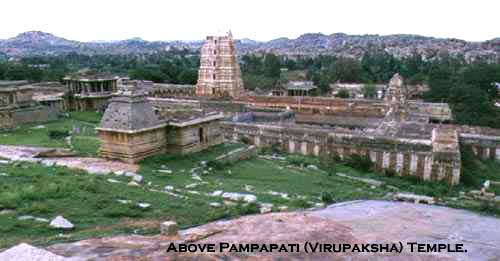 At the Hampi bazaar, at the foot of the awesome Pampapati temple, I was
accosted by a soft spoken man speaking good english, who asked me if I
wanted a private guide for the day.
At the Hampi bazaar, at the foot of the awesome Pampapati temple, I was
accosted by a soft spoken man speaking good english, who asked me if I
wanted a private guide for the day.
As a wise-ass traveler and a ten-day veteran of India's incessant attempts
at selling me something, ANYTHING, I declined his offer, effortlessly
blending courtesy with polite disdain. Unsurprisingly, he insisted, but
in a different fashion from his hawking brethren.
-"Would you like to buy some film?"
-"No, thanks, I already have some."
-"I have 100, 200, 400 ASA."
-"I already said no!"
-"OK, how about some film, then?"
-"Aaaargh!!!!"
He calmly and convincingly explained that Hampi is very large, most
sites are unmarked and a good distance apart, and that with a knowledgeable
guide I wouldn't miss anything. Furthermore, at 250 rupees for the day,
he was cheaper than the other guys (Yeah, right!).
Out of weariness, or unconsciously agreeing with his argument, I relented
and said yes. Never have I been so glad of a snap decision to do something
I didn't want to do at first! He was knowledgeable indeed, educated, friendly,
and westernized in the oddest ways (more on that later).
The great Pampapati temple (aka: Virupaksha Temple) is the oldest
and most sacred in Hampi. Parts of it are older than the founding of the
city and kingdom of Vijayanagar, Hampi's original name. The temple's first
gate is topped by a lofty pyramidal tower entirely covered with hundreds
of sculptures and carvings of men, women, hunting scenes, and many other
representations, all diminishing in size as the tower narrows toward the
top. Around all these statues frolic hundreds of monkeys. At least they
do in the evening. At midday, I could only spot a handful, as Swami (my
guide) explained that they leave for the surrounding fields in the morning,
only to return at sunset. Since I had already booked my sleeper berth
on the 8:30 Bangalore Express out of Hospet that very night, I missed
most of them!
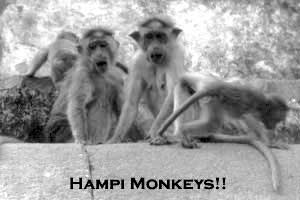 Passing that first gate, you come into a large courtyard with another
similar gate, only smaller, at the other end. That second gate opens into
another large court with verandahs all around on pillars of stone, a sacred
elephant is cared for in a corner and in the center of this court is the
house of the Bhuvanesvari shrine. The shrine is lit by hundreds of oil
lamps and candles housed in small holes in the wall. Images of various
small idols are everywhere, the principal one being a round stone lingam
(Shiva's penis), the object of much veneration. There is a larger lingam
nearby in the ruined Shiva shrine between the Narasimha statue and the
main Krishna temple. Swami told me it is the second largest in all India.
Shiva's wife Parvati must have been a happy woman!
Passing that first gate, you come into a large courtyard with another
similar gate, only smaller, at the other end. That second gate opens into
another large court with verandahs all around on pillars of stone, a sacred
elephant is cared for in a corner and in the center of this court is the
house of the Bhuvanesvari shrine. The shrine is lit by hundreds of oil
lamps and candles housed in small holes in the wall. Images of various
small idols are everywhere, the principal one being a round stone lingam
(Shiva's penis), the object of much veneration. There is a larger lingam
nearby in the ruined Shiva shrine between the Narasimha statue and the
main Krishna temple. Swami told me it is the second largest in all India.
Shiva's wife Parvati must have been a happy woman!
I won't describe the many other temples I saw that day, though a special
mention must be made of the extraordinary Vitthala temple and its musical
columns. Carved out of single blocks of granite, the fluted columns each
resonate in a different sound when hit, for some unearthly rock music!
The Krishna temple (I prayed to Him for the return of my beloved!!) was
grandly dark and inhabited by bats, for a bizarre Transylvanian effect!!
All of them ranged from beautiful to magnificent, and evoked much awe
and wonder in this atheist's heart.
For some reason, the subject of smokeable drugs came up (Now, you know
me!), and Swami asked me the magical question: -"Would you like to
smoke something?
-"My man! Let's go." I blissedly blurted out!
So we climbed up a hill overlooking Pampapati temple, in the direction
of a group of small Jaina shrines.
In one of them, Swami told me, lived this sadhu saint who had been fasting
for the past month, only drinking water and smoking ganja (the word originated
in India before passing on to Jamaica and points west. Dreadlocks also
come from India, and I saw two Holy Beggars with heavily matted dreads
reaching the ground!!). 
I knew then I was in for a treat.
The thirty-something sadhu, wearing turban and orange loincloth, reclined
in a corner, entranced and smiling at a small boy haltingly reading sacred
words from a holy book. Ten or so people lounged or cross-legged about,
obviously becharmed by his saintly presence. Now, unlike its Christian
equivalent where contemplative fasting would involve ponderous gloom and
mortification of the flesh, the sadhu and his companions smiled happily,
cracked jokes, and made me feel welcome and included. The sadhu then ritually
offered me germinating beans out of an earthenware urn, a piece of coconut,
a glass of water (I passed on that one!) and the first of many shiloms.
Om Shiva!!
A second sadhu came in moments later, beamed a toothless smile at me when
Swami told him what he brought me for, and pulled out his own shilom and
stash to, obviously, put me closer in touch with the godhead!
The air crackled with vitality!
Now, I would like you to stop and think about this for a moment.
There I was, a Philly Parisian in an ancient temple reeking with transcendence,
dedicated to Ganesha (or was it Vishnu or Laxmi, I forget) by the side
of a still, emerald-green pond, sitting with friendly locals and two holy
men turning me on like there's no tomorrow, while outside, under blue
skies and a vibrant sun, overlooking the majestic Pampapati temple, goats
and monkeys frolicked, whilst a soft breeze cooled the fragrant Karnatic
air.
And that is why, later, while passing under a sacred marmosa tree, I thanked
Virupaksha, Lord of the Nagas, the Red King who ruled over the Western
Quarter.
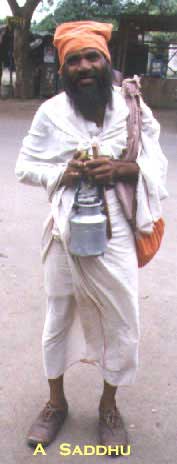
I mentioned earlier that Swami was oddly westernized. He told me how
he and his friends organize "acid parties" (what!) in Hampi
where they live. (He was the first of several to tell me about acid. Subsequently,
I found out it is quite the thing with young Indian hipsters, who get
it from Italians (!!), fanning it from Goa into South India). My Hampi
head friends set up a sound system in a temple courtyard (beats the Elk's
Lodge or a West Philly squat!), drop, and groove the Deccan night away,
floating in millennial reverie as they, no doubt, ponder the ebb and flow
of sentient existence. Nonplussed, I asked him what kind of music they
listened to.
- "Acid music of course!", he replied, looking surprised that
he should have to state the obvious.
-"Indian acid music?" I ask.
-"No, western!"
At that point, I was so flabbergasted that I neglected to ask him what
he meant by that: Dead, Airplane, Jimi, Techno/Ambient/Chill/House....?
Next time I see him, I'll ask and let you know! Another thing I noticed
(and not limited to Hampi) was the complete lack of graffiti and vandalism.
These sites, albeit abandoned and no longer in devotional use, are sacred,
and it wouldn't cross anybody's mind to break anything: bad karma assured
otherwise!
There is a large statue of Ganesha whose trunk has been broken off. The
rest of the statue is in perfect condition, and I assumed some hooligans
broke it off in a drunken stupor. "Not so", said Swami. "The
Muslims did it when they sacked the city in 1565."
Finally, while the Karnataka State Antiquity Dept. must be warmly congratulated
for the great job it's doing to salvage and restore all these glorious
wonders, I must wish reincarnation as a cockroach upon the bureaucrat
who allowed the quasi-ubiquitous electrical lines and poles to be so haphazardly
laid out, nearly everywhere. Cheap-looking , they ruined dozens of tremendous
photo opportunities.
CITIES
Mumbai is a hell hole, I already told you that. Beggars everywhere, children in rags, hovels and huts on every street, people sleeping and living on stoops, in doorways, beside dumpsters. Organic garbage and plastic bags strewn all about, cows in downtown streets eating said garbage and shitting it out all over the place; the stench of it all combining with an omnipresent cloud of diesel fumes and the incessant din of car horns honking without let up! Need I go on?!
Pune (Poona) is about the same, maybe a little less so, but I can't quite judge. I spent eight hours there, splitting my time between trying to sleep in a downtown park and finding a cozy place to vomit the bad chicken I had eaten the night before in Aurangabad!
Panjim (or Panaji),
 |
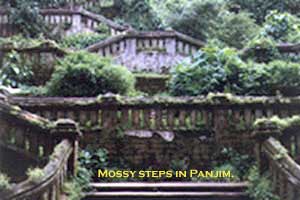 |
Goa's capital, was a lot better, but torrential rains and 200% humidity
(it was so humid that, even when it didn't rain, you could SEE
the air!) had everything dripping with a sickly rotting mossy mold, dark
green and cancerous.
I stayed at the Xavier Beach Resort ("We're closed this time of year,
sir, but if you don't mind being the only customer, we'll be glad to open
for you". And I didn't mind, so they did!!).
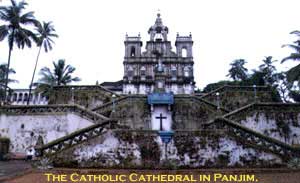 It's
in Candolim Beach, two hundred yards from the Arabian sea, along a red-earth
path pocked and puddled here and about with carmine copper waters.
It's
in Candolim Beach, two hundred yards from the Arabian sea, along a red-earth
path pocked and puddled here and about with carmine copper waters.
Cows and buffaloes munched placidly amidst Banyan trees taking root and
root again alongside cacti scattered in coconut groves. Coarse sand on
the beach, grey waters, darker skies, and many fishing-boats in the choppy
water.
"Don't go in the water , it's dangerous during monsoon season"
said my hosts.
I scoffed looking at the puny waves, went in to my knees and, within seconds,
one of the puny waves in question had pulled me under and rolled me on
the sand.
I managed to stand up, gasping for air, and decided to trust the locals
about local mores and practices!
Bangalore
My last night in India and I whipped out the credit card to stay at the
fairly swank Woodlands Hotel. That night I took a walk near Brigade Road,
Bangalore's swinging neighborhood. Shops, restaurants, bars, computer
emporiums, a cyber cafe,...., why, you could have thought you were on
South Street, Phila., or in the Village. I went for a beer at the Pub
World for Kingfisher on tap. Grad students and yuppies, jeans and Polo
shirts, Bryan Adams and Guns and Roses on the juke, India-Sri Lanka cricket
test-match on the telly, all-men except for a handful of accompanied,
escorted, women...
I went back to the hotel, bought two quarts of Kingfisher at a corner
stand, a pack of Gold Flake cigarettes for a nicotine high, and spent
two hours flicking channels between cricket, more cricket, Hindi or Kannada
musicals, several channels of MTV-style music stations, and the unavoidable
CNN International!
Mysore

And now, we're in Mysore, deep into southern Karnataka, and the last
stage on my short trip. What a perfect way to end on a good note. A very
pleasant city, small by Indian standards (only a million inhabitants!),
fairly clean and with broad avenues, trees and parks, nice buildings NOT
uniformly made of leprous cement blocks for a change. Of course, there
was the obligatory diesel cloud, and dozens of cows, horses and stray
dogs doing their thing untroubled on every street. But an airy haven nevertheless.
Mysore has several beautiful and old fruit and vegetable markets, including the Devaraja market, which my new friend Vijay kept referring to ironically as "the world-famous Devaraja market!"
Strolling through it one day, in search of incense and essential oils,
I stopped by this young man's stall displaying joss-sticks and multicolored
vials. He spoke english, of course, and even a little French and he turned
out to be of good advice and a fount of information. To wit: he informed
me that the sandalwood oil trade is a state monopoly in Karnataka, from
sandal forests to bottled essences. He warned me: "don't go to the
cheating markets. They'll sell you official-looking sealed bottles, but
they'll remove the real oil with a syringe, to replace it with synthetic
stuff."
The real question for me was: how do I tell the difference between the
cheat and the straight-arrow, in a country where everybody is always so
nice and drips honesty while trying to sell me something?!
the next day I'm on the Akbar Road in Mandi Mohalla district, near another market, a small one with a look-out tower topping the entrance gate. As I'd grown accustomed to, I let myself carried in a dream-like state by the hubbub of merchant life, women in saris buying mysterious looking legumes and tubers, people going from shop to stall, eating golden fried delights as they go, smiling at me and asking for my name, as I photograph delivery men in orange or white turbans driving ox-carts or carrying mountains of jute-cloth bags on their heads. Life is good!
All of a sudden, I find myself face to face with this ten year old boy, all smiles and eagerness, asking me if I want to visit an incense factory and smell rare oils. Cheap, too! Keeping in mind yesterday's warning, I say OK to the incense part, and before I can think any further, I find myself in a capharnaum of a shop brimming over with soaps and fragrances, herbs and ayurvedic distillates, spices in glass vessels of all sizes and shapes. In the shop's back room is the "incense factory"! The boy's name is Samul, and he grabs a handful each of charcoal and sandalwood powder, mixes the two in a copper bowl, adds water, stirs quickly and spreads the mixture on a stone slab, palm-rolls it on a wooden stick, and presto, incense. I'm amused by his effort to put on a show for me, I like his gung-ho energy, and buy ten sticks from him, at ten rupees way too much money, but what the hell, I liked his act. When he wants to bring in his big bro for the oil sale spiel, I say no and leave. Look of dismay on Samul's face, as if his new friend from across the dark waters had been torn away from him!
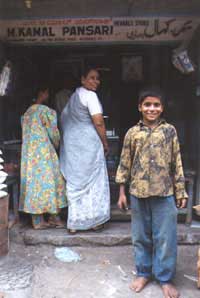 Lil' Samul in front of his shop! |
I then took a rickshaw to the state sandal oil factory, a few miles south.
Fascinating place drowning in the headiest fragrances
imaginable. I took the tour with an Italian couple from Roma, and we all
retreated to the factory shop afterwards. "Soap and incense, no problem",
said the clerk, "but we're out of oil, so sorry, what with export
demand so high, we can't keep any stock on hand"!
Big disappointment from the three of us, but to the rescue comes the rickshaw
driver.
-"I know a place", he says "good oil, cheap. I take you"
-"Great", we think. "Let's go!"
And in no time, we find ourselves at... Samul's place, on Akbar Road!
Small world, I think, as the kid beams at us, ushers us into that backroom
with the bottles and the powders and the sumptuous reek.
And this time, we're in for the big oil show with Samul's older brother
Sagheer. Half an hour later, I have gardenia and white Mogra flower on
the back of both my hands, two kinds of jasmine on my wrists, rose on
one forearm and sandalwood on the other! All of the headiest fragrance,
luxuriant and intoxicating, earthy and airy all at once, floating spells
about the dim room, soothing me into their thrall. Sagheer is totally
organized, with a pre-printed price list in six currencies, and description
of the fragrances in as many creative foreign syntaxes.
So I buy a bottle of jasmine, but still feeling the faint tug of a warning,
I go for only one phial of sandalwood. The two Italians, who obviously
have Roman biz in mind, buy six along with a dozen more assorted oils.
We say goodbye, I take a picture of Samul and Sagheer, give the kid a
pen (he asked) and some French coins (he loved), we promise to send all
the tourists we meet, and, "of course we'll be back!"
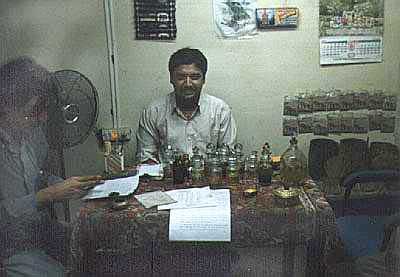 Big brother Sagheer smiling at the tourists he just rolled! |
I drop my buys at the hotel and return to Devaraja market for more photos
and catharsis. Within moments, two young men approach me with the usual
"What name, what country, would you like to smoke some ganja?".
They were called Shankar and Vijay and I followed them through a daedalus
of small streets and alleys, dodging cows and puddles, to a small cafe
where we smoked and drank tchai. At one point, I bring up the Samuls and
my oily transaction. In no time Shankar interrupts me and, with a grin,
proceeds to tell all that happened as if he'd been there the whole time!
They laugh gently. -"You got cheated. This is an act they play for
the tourists".
Sure enough, when I checked the sandal later, I noticed a minute pinprick
in the cork stopper, and the oil, while actual sandalwood, was ok at best,
much different from the thick and rich and sweet concentrate Sagheer showered
on my arm earlier.
Anyway, Shankar and Vijay tell me not to be upset, it's past and done,
and it's dharma! They say they know this fellow in Devaraja market who
sells good oils and speaks French.
-"I know him!" I say.
-"Let's go see him." they say.

And so, feeling awkward and stupid and pissed off, I follow them back
to the good merchant in his market shop who is appalled at my naivete.
-"I told you not to go, I explained to you what they do, I warned
you. How could you do it?"
And it is feeling guilty as hell that I buy five different oils from him
(all very good, I might add!), and I depart with promises of eternal friendship,
I'll be in touch, Namaste, and all that!
Afterwards, I thought: "What could I have done?"
If you end up being so paranoid about being conned, you end up holed up
in your hotel, buying nothing and returning home empty-handed from this
fascinating land of plenty. And all I ended up losing was the equivalent
of $12! Cheap for the adventure!
THE MYSORE PALACE
The guide book I had, waxed lyrical at great length about the Mysore
Maharaja Palace, one of the most beautiful in all India, it said. With
visions of a centuries-old palace, sculpted marble lace-works, and armies
of divine statues and their retinue of demigods and heroes, I aimed for
this purported architectural wonder. How can I convey the sense of disappointment
that engulfed me when coming face to face with that royal monstrosity!
Forget ancient Indian architecture. Built in 1894 by a British architect
(shame), it epitomizes Victorian bad taste (check that! Bad taste does
have its charms. Let's say Victorian NO taste!!). In an attempt to hide
the Brits' historical lack of imagination and creativity in all things
unrelated to mercantilism, behind a feeble attempt at local color, the
architect (sic) topped his railway-station horror with a few cupolas,
minaret like, achieving thereby the tackiest effect imaginable. It would
make a fine megalomaniac Rotary Lodge Temple, but an Indian Maharaja's
palace?!....
 The Mysore Palace!!
The Mysore Palace!!
Having visited earlier in the day the pure marvel that was Tipu Sultan's
summer pavilion, the shocking contrast between the two structures couldn't
have been more blatant! Built a mere one hundred years earlier, the Tipu's
mansion is a masterpiece of airy elegance with its carved wooden arches
and sublime filigreed decorative patterns. And I wondered: Could Indian
architects have reached such decadence in a single century, and could
their talents have so atrophied as to make their commissioning impossible?
Obviously not. If decadence is to be found, it lies with the Indian ruling
elite of the period, so enslaved to British imperial power had they become,
that the shameless aping of the colonial invader was the only course of
action they could conceive of!
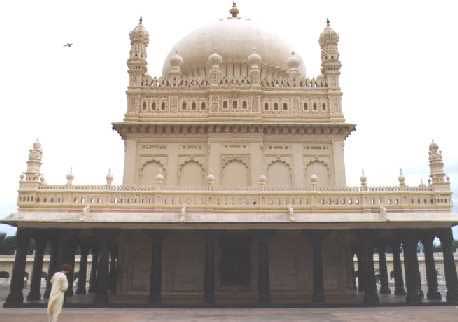
Tippu Sultan's burial Mausoleum, near Mysore.
CODA
At the end of my first week in India, I tried to advance my return flight by a few days, so freaked out was I by the horrifying human misery and filth. All seats were booked and I wasn't able to do it. The wonderful second week of my stay made me very happy it couldn't be done, but still I was glad to return to Paris. Now, four months later, unable to see a day pass without thinking of India, the India of a million gods, divine musicians, celestial dancers, the India of aromatic magic, of flowers in garlanded temples, of ineffable marvels and wonders without end, I now think of when, and how, and with whom will I return?
I'll see you there!
All Photographs Copyrighted © Michel Polizzi 1997-2000
